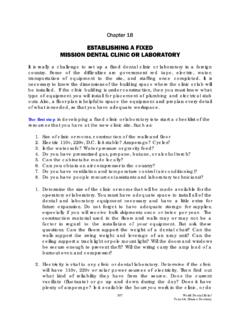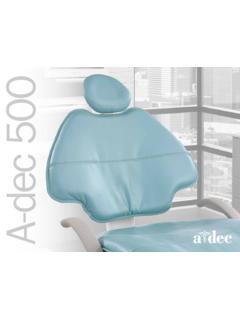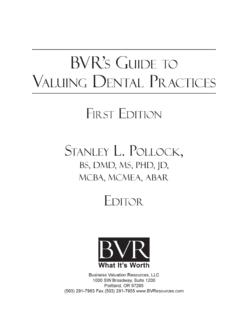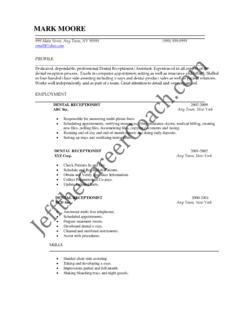Transcription of Frequently Asked Questions on the Dental Office …
1 Office of Water EPA 822-S-17-002 November 2017 Frequently Asked Questions on the Dental Office category Rule EPA developed these FAQs based on the Dental Office category Rule at 40 CFR Part 441. Dental facilities may be subject to additional or more stringent state or local requirements than those in the rule. Who must comply with this rule? The vast majority of Dental facilities that discharge wastewater into a publicly owned treatment works (POTW) ( , municipal sewage system) are subject to this rule ( Dental dischargers ). However, there are some exceptions. Dental dischargers that do not place Dental amalgam, and do not remove Dental amalgam except in limited emergency or unplanned, unanticipated circumstances are exempt from any further requirements as long as they certify as such in a one-time compliance report to their Control Authority. Dental dischargers that exclusively practice one or more of the following specialties are not subject to any of the rule s requirements, including submission of a one-time compliance report to their Control Authority: Oral pathology Oral and maxillofacial radiology Oral and maxillofacial surgery Orthodontics Periodontics Prosthodontics Additionally, mobile units are not subject to any of the rule s requirements, including submission of a one-time compliance report to their Control Authority.
2 A mobile unit is a specialized mobile self-contained van, trailer, or equipment used in providing dentistry services at multiple locations. Dental facilities that do not discharge their amalgam process wastewater into a POTW are also not subject to any of the rule s requirements, including submission of a one-time compliance report to their Control Authority. For example, Dental facilities that discharge amalgam process wastewater into a septic system are not subject to this rule. To determine if the EPA rule applies to your facility, see (Applicability). 2 What are the basic requirements of the rule? The requirements for Dental dischargers subject to the rule are detailed in the rule. Here, they are summarized as follows: Ensure the removal of Dental amalgam solids from all amalgam process wastewater via amalgam separator(s) or equivalent device(s) that meet the standard of the final rule. See (a)(1-2) for an existing source and for a new source. Implementation of two best management practices.
3 See (b) for an existing source and for a new source. Comply with reporting requirements. See (a). Maintain and make available for inspection certain records documenting compliance. See (b). What are the compliance deadlines? Dental dischargers (under any ownership) that were discharging into POTWs prior to July 14, 2017 ( existing sources ), must be in compliance with the standards by July 14, 2020, and submit a one-time compliance report certifying such by October 12, 2020. Dental dischargers whose first discharge to a POTW occurs after July 14, 2017 ( new sources ) must be in compliance with the standards immediately and submit a one-time compliance report certifying such within 90 days after first discharge to a POTW. If the Dental discharger transfers ownership, what are the deadlines for a new owner to submit a one-time compliance report? If an existing source Dental discharger transfers ownership, the new owner must submit a new one-time compliance report to the Control Authority by October 12, 2020, or if the transfer occurs after July 15, 2020, no later than 90 days after the transfer.
4 If a new source Dental discharger transfers ownership, the new owner must submit a new one-time compliance report to the Control Authority no later than 90 days after the transfer. Does this rule require standards for the type of amalgam separator I install? Yes. For an existing source see (a)(1-2). For a new source, see Do I have to replace my existing separator? It depends. (a)(1)(iii) of the rule allows Dental dischargers that had installed and were using an amalgam separator prior to June 14, 2017 to continue to use it until June 14, 2027 if it is functioning properly and does not need to be replaced. This is referred to as a grandfathering provision or clause. The facility must still file a one-time compliance report certifying such by October 12, 2020. If the amalgam separator meets the standards of the rule, see (a)(1-2), the grandfathering provision need not apply. If a Dental discharger covered by the grandfather clause transfers ownership, the new owner may continue using the grandfathered separator until June 14, 2027 if it is functioning properly and does not need to be replaced.
5 The new owner must still file the one-time compliance report. What are the correct dates that are relevant to the grandfathering provision in (a)(1)(iii)? In the original Federal Register publication of the final rule, there was a typographical error in one of the dates in the grandfathering provision. The corrected version of the provision is: A Dental discharger subject to this part that operates an amalgam separator that was installed at a Dental facility prior to June 14, 2017, satisfies 3 the requirements of paragraphs (a)(1)(i) and (ii) of this section until the existing separator is replaced as described in paragraph (a)(1)(v) of this section or until June 14, 2027, whichever is sooner. (emphasis added) I have a wastewater retaining tank technology that collects all amalgam process wastewater and my Dental facility does not discharge any amalgam process wastewater to a POTW. Am I exempt from the Dental Office category Rule? Yes. See (e). As long as the Dental facility does not discharge any amalgam process wastewater from the tank or otherwise, it is not subject to any of the rule s requirements, including submission of a one-time compliance report to their Control Authority.
6 My Dental facility has a technology that removes amalgam from wastewater as efficiently as an amalgam separator, but it is a different type of device, and therefore does not qualify to meet the ISO standard for amalgam separators. Does this device satisfy the requirements of this rule? The rule includes a provision at (a)(2) that allows the performance standard of the rule to be met with the use of an amalgam-removing technology other than an amalgam separator ( , equivalent device). EPA included this provision to allow use of amalgam removal devices that are equivalent to amalgam separators in several respects ( the percentage of removal of mass of solids) but that may not fall under the amalgam separator classification. The equivalent device is required to meet the same requirements and removal efficiencies, as specified in (a)(1-2) or Does this rule have recordkeeping requirements for Dental dischargers? Yes. See Does this rule have inspection or maintenance requirements for Dental dischargers?
7 Yes. See What information must be in my one-time compliance report? See A sample one-time compliance report that includes the information required by the rule may be found at Note to Dental dischargers: Please contact your Control Authority to ensure that you have obtained the correct form from your Control Authority. In addition, you may be subject to additional reporting requirements in accordance with state and local law. Where should Dental dischargers send their one-time compliance report? Who is my Control Authority? Dentists should obtain and send their one-time compliance report to their pretreatment Control Authority. Your Control Authority is either a local wastewater utility, a state environmental agency, or a EPA Regional Office . If your Dental facility is in Alabama, Connecticut, Mississippi, Nebraska or Vermont: your Control Authority is your state agency. Contact information for each state is available at (select the State Agency Contacts tab). For dentists in all other states: contact your EPA Regional Office , your local wastewater utility, or your state agency Pretreatment Coordinator to identify your Control Authority.
8 Pretreatment contact information for EPA headquarters, EPA Regions, and state agencies is available at (select the appropriate tab). 4 My practice is in compliance with the standards in the rule and has submitted a one-time compliance report. It is now changing ownership. Do I or the new owner need to submit a new one-time compliance report? Yes. If a Dental discharger transfers ownership of the facility, then the new owner must submit a new one-time compliance report to the Control Authority. See above for compliance deadlines and (a)(4). Is there a website where I can submit my one-time compliance report electronically? Check with your Control Authority. Does the final rule prohibit the use of oxidizing or acidic cleaners in Dental unit water lines, chair-side traps, and vacuum lines? Yes. The clause that follows ( including but not limited ) is not an exhaustive list of oxidizing or acidic cleaners or qualities that make a cleaner oxidizing or acidic. For example, a cleaner that is oxidizing would be prohibited even if its pH is between 6 and 8.
9 Does the prohibition on the use of oxidizing or acidic cleaners in Dental unit water lines apply to cleaners used in the water supply lines that connect to items such as handpieces, ultrasonic scalers or air/water syringes? No. The purpose of the best management practice (BMP) specified in (b)(2) is to prohibit the use of cleaners that solubilize mercury from Dental amalgam in the wastewater lines in a Dental facility. In developing the rule, EPA did not evaluate the use of cleaning products that may be used in Dental equipment that is connected to water supply lines such as handpieces, ultrasonic scalers, or air/water syringes. While de minimus amounts of such products may eventually be indirectly discharged through a wastewater line in a Dental facility, the prohibition in (b)(2) was not intended to prohibit Dental unit water line cleaning products when those products are used in water supply lines to ensure the safety of the water that dentists place in their patient's mouth.
10 Is the amalgam collected in the separator considered a hazardous waste under the Resource Conservation and Recovery Act (RCRA)? Yes. The amalgam collected in a separator is likely to be a hazardous waste under RCRA due to the mercury and silver content of the amalgam. However, Dental offices producing less than 100 kg of hazardous waste/month AND less than 1 kg of acute hazardous waste per month are considered Very Small Quantity Generators (VSQGs are regulated under ) and are exempt from most RCRA requirements for the disposal of their hazardous waste (Note that VSQGs were formerly called conditionally exempt small quantity generators (CESQGs) but were renamed in November 2016). EPA generally does not expect Dental offices collecting amalgam waste to be above the VSQG threshold. A generator must count all of the hazardous waste it generates in a calendar month, not just the amount of amalgam, to determine what RCRA generator category is appropriate. If you believe you may qualify as a Small Quantity Generator ( Dental Office that produces 100-1000 kg of hazardous waste per month AND less than 1 kg acute hazardous waste per month) or a Large Quantity Generator ( Dental Office generates more than 1000 kg of hazardous waste per month OR more than 1 kg of acute hazardous waste per month), please contact your state hazardous waste authority to understand your requirements for the management of hazardous waste.















